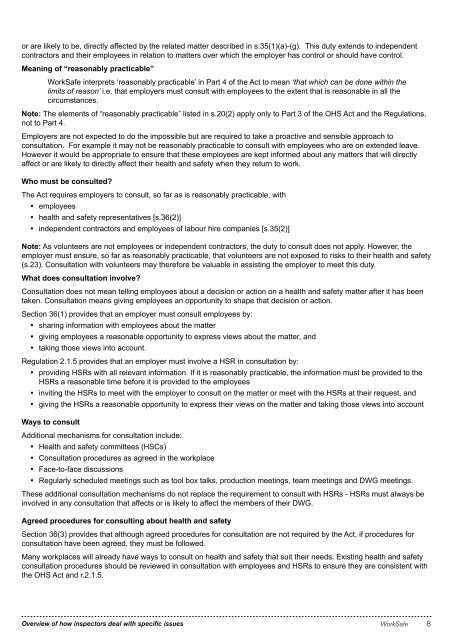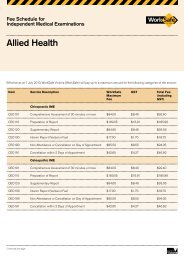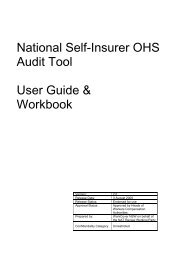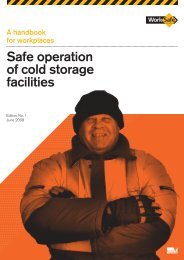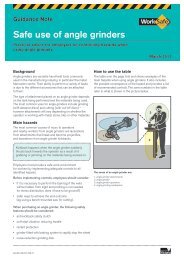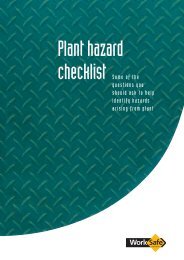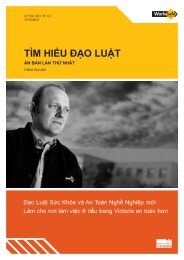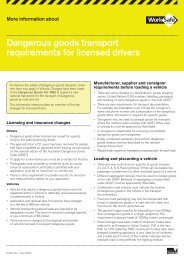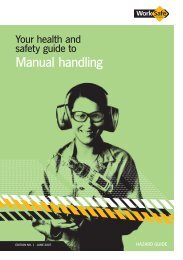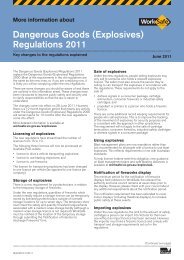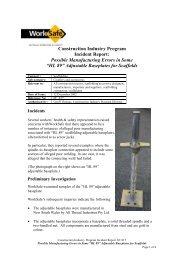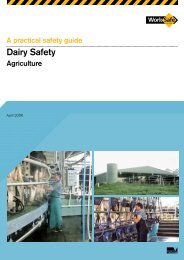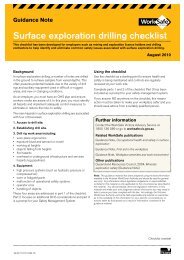or are likely to be, directly affected by the related matter described in s.35(1)(a)-(g). This duty extends to independentcontractors and their employees in relation to matters over which the employer has control or should have control.Meaning <strong>of</strong> “reasonably practicable”<strong>WorkSafe</strong> interprets ‘reasonably practicable’ in Part 4 <strong>of</strong> the Act to mean ‘that which can be done <strong>with</strong>in thelimits <strong>of</strong> reason’ i.e. that employers must consult <strong>with</strong> employees to the extent that is reasonable in all thecircumstances.Note: The elements <strong>of</strong> “reasonably practicable” listed in s.20(2) apply only to Part 3 <strong>of</strong> the OHS Act and the Regulations,not to Part 4.Employers are not expected to do the impossible but are required to take a proactive and sensible approach toconsultation. For example it may not be reasonably practicable to consult <strong>with</strong> employees who are on extended leave.However it would be appropriate to ensure that these employees are kept informed about any matters that will directlyaffect or are likely to directly affect their health and safety when they return to work.Who must be consulted?The Act requires employers to consult, so far as is reasonably practicable, <strong>with</strong>• employees• health and safety representatives [s.36(2)]• independent contractors and employees <strong>of</strong> labour hire companies [s.35(2)]Note: As volunteers are not employees or independent contractors, the duty to consult does not apply. However, theemployer must ensure, so far as reasonably practicable, that volunteers are not exposed to risks to their health and safety(s.23). Consultation <strong>with</strong> volunteers may therefore be valuable in assisting the employer to meet this duty.What does consultation involve?Consultation does not mean telling employees about a decision or action on a health and safety matter after it has beentaken. Consultation means giving employees an opportunity to shape that decision or action.Section 36(1) provides that an employer must consult employees by:• sharing information <strong>with</strong> employees about the matter• giving employees a reasonable opportunity to express views about the matter, and• taking those views into account.Regulation 2.1.5 provides that an employer must involve a HSR in consultation by:• providing HSRs <strong>with</strong> all relevant information. If it is reasonably practicable, the information must be provided to theHSRs a reasonable time before it is provided to the employees• inviting the HSRs to meet <strong>with</strong> the employer to consult on the matter or meet <strong>with</strong> the HSRs at their request, and• giving the HSRs a reasonable opportunity to express their views on the matter and taking those views into accountWays to consultAdditional mechanisms for consultation include:• Health and safety committees (HSCs)• Consultation procedures as agreed in the workplace• Face-to-face discussions• Regularly scheduled meetings such as tool box talks, production meetings, team meetings and DWG meetings.These additional consultation mechanisms do not replace the requirement to consult <strong>with</strong> HSRs - HSRs must always beinvolved in any consultation that affects or is likely to affect the members <strong>of</strong> their DWG.Agreed procedures for consulting about health and safetySection 36(3) provides that although agreed procedures for consultation are not required by the Act, if procedures forconsultation have been agreed, they must be followed.Many workplaces will already have ways to consult on health and safety that suit their needs. Existing health and safetyconsultation procedures should be reviewed in consultation <strong>with</strong> employees and HSRs to ensure they are consistent <strong>with</strong>the OHS Act and r.2.1.5.<strong>Overview</strong> <strong>of</strong> <strong>how</strong> <strong>inspectors</strong> <strong>deal</strong> <strong>with</strong> <strong>specific</strong> issues<strong>WorkSafe</strong> 8
Agreed procedures for consultation must:• be consistent <strong>with</strong> the OHS Act (i.e. must enable the employer to meet their consultation obligations and cannotremove the powers <strong>of</strong> a HSR or functions <strong>of</strong> a HSC)• be the subject <strong>of</strong> consultation <strong>with</strong> employees before they are implemented (if there are HSRs, they must beinvolved in this consultation)• be agreed. This means that it is consensual and there has been genuine consultation and agreement between theemployer, the HSRs and employees. The procedure must not be imposed by one party or the other or arise out <strong>of</strong> aflawed process for reaching agreement. A flawed process for reaching agreement may be one:• where only a select group <strong>of</strong> employees participated and agreed <strong>with</strong> the employer, or• where agreement is reached through an unrepresentative process eg not all HSRs or all HSC members or allrelevant employee representatives, as the case may be, were able to participate in the agreement process.Where a consultation procedure is consistent <strong>with</strong> the OHS Act, has been the subject <strong>of</strong> consultation <strong>with</strong> employees, is theresult <strong>of</strong> genuine agreement, is being followed by the employer and the employer has not otherwise breached the OHSlegislation, then <strong>WorkSafe</strong> will consider the employer to be compliant <strong>with</strong> the consultation provisions <strong>of</strong> the OHS Act.When an inspector enters a workplace to <strong>deal</strong> <strong>with</strong> an allegation that an employer has failed to consult on OHS matters,the inspector will enquire into the matter <strong>with</strong> the person raising the allegation, relevant HSR(s)/deputy HSR(s) and theemployer/employer’s representative to obtain their views on what has occurred.The inspector will also enquire into the matter <strong>with</strong> other persons if the views <strong>of</strong> the above-mentioned persons differ andseek documentary evidence <strong>of</strong> the various views.The inspector may determine as follows:1. Consultation did occur - the parties will be advised <strong>of</strong> this;2. Consultation did not occur and was not reasonably practicable in the circumstances - the parties will be advised<strong>of</strong> this, a recommendation made to look into practicability for the future, and benefits <strong>of</strong> a consultation procedurepromoted;3. Consultation did not occur, was reasonably practicable in the circumstances, and the change is not yetimplemented – the parties will be advised <strong>of</strong> the <strong>of</strong>fence, guidance and advice will be provided on futurecompliance, and an improvement notice will be issued requiring consultation to now occur;4. Consultation did not occur, was reasonably practicable in the circumstances, the change is already fullyimplemented, and there is no evident risk to persons’ health and safety - the parties will be advised <strong>of</strong> the<strong>of</strong>fence, guidance and advice will be provided on future compliance, the inspector will determine if it is reasonablypracticable to re-open the matter and if so issue an improvement notice requiring consultation to now occur orotherwise will promote benefits <strong>of</strong> a consultation procedure;5. Consultation did not occur, was reasonably practicable in the circumstances, the change is already fullyimplemented, and there is evident risk to health and safety <strong>of</strong> employees as a result <strong>of</strong> the change – the parties willbe advised <strong>of</strong> the <strong>of</strong>fence, guidance and advice will be provided on future compliance, benefits <strong>of</strong> a consultationprocedure will be promoted, and the evident risk issues will be separately <strong>deal</strong>t <strong>with</strong> by the inspector includingissuing notices where appropriate6. A valid agreed procedure was in place, but not followed by the employer - the parties will be advised <strong>of</strong> the<strong>of</strong>fence, guidance and advice will be provided on future compliance, an improvement notice will be issued requiringconsultation to now occur in accordance <strong>with</strong> the agreed procedure, and if there are other substantive breaches <strong>of</strong>the Act or regulations evident these will be separately <strong>deal</strong>t <strong>with</strong>;7. A purported agreed procedure is not valid – the parties will be advised that the procedure cannot be used for thepurposes <strong>of</strong> consultation, and guidance will be provided on what a new agreed procedure should include for it to bevalid.In relation to <strong>of</strong>fences identified in scenarios 3, 4, 5 and 6, <strong>inspectors</strong> may also consult <strong>with</strong> their Group Leader andconsider referring the failure to consult as required by the OHS Act for further investigation and enforcement action whereexacerbating factors <strong>of</strong> recklessness, recalcitrance or recidivism apply.Note: The five indicia for what constitutes an agreed procedure are:• The procedure must have been the subject <strong>of</strong> consultation <strong>with</strong> any HSR and employees directly affected or likely tobe affected [see s.35(1)(d)(ii)]• The procedure must have been agreed, that is being subject <strong>of</strong> consent and genuine agreement between theemployer and relevant employees, not imposed by one party or the other or arising out <strong>of</strong> a flawed process forreaching agreement (a flawed process for reaching agreement may be one where only a select group <strong>of</strong> employeesparticipated and agreed <strong>with</strong> the employer, or - where agreement is intended to be reached through a representative<strong>Overview</strong> <strong>of</strong> <strong>how</strong> <strong>inspectors</strong> <strong>deal</strong> <strong>with</strong> <strong>specific</strong> issues<strong>WorkSafe</strong> 9


